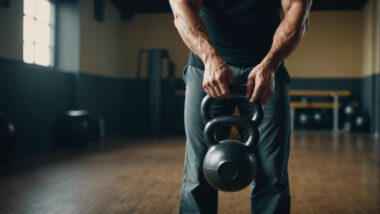Get ready to target your chest muscles from multiple angles with kettlebell chest flys. Start by preparing your body – stand with your feet shoulder-width apart, engage your core, and relax your shoulders. Lie on a bench with a kettlebell in each hand, keeping your wrists straight and elbows slightly bent. Lower the kettlebells as far as comfortable, then squeeze your chest muscles to lift them back up, focusing on the contraction. Maintain constant tension and control throughout the movement. Now that you've got the basics down, dive deeper into perfecting your form and maximizing the effectiveness of this powerful exercise.
Key Takeaways
- Stand with feet shoulder-width apart, engage core, and relax shoulders to maintain stability and proper form.
- Hold kettlebells with straight wrists and slightly bent elbows, lowering them as far as comfortable without passing the torso.
- Squeeze chest muscles to lift kettlebells back up, focusing on slow and controlled movement.
- Engage chest muscles by imagining hugging a tree trunk with arms, avoiding reliance on shoulders or arms.
- Choose a weight that allows constant tension throughout the entire range of motion, controlling the weight and range to target chest muscles effectively.
Preparing for the Kettlebell Fly
Before you grab a kettlebell, take a moment to ensure your body is properly aligned and engaged to maximize the effectiveness of the fly exercise. This is crucial to target your chest muscles effectively and prevent any potential injuries.
Stand with your feet shoulder-width apart, toes pointing slightly outward, and engage your core muscles to maintain stability. Keep your shoulders relaxed and down, avoiding any scrunching or tensing.
As you prepare for the kettlebell fly, focus on maintaining a full range of motion. This will allow you to move your arms freely and efficiently, targeting your chest muscles from multiple angles.
Take a deep breath, feeling your chest expand and contract. This will help you connect with your chest muscles and prepare them for the upcoming exercise.
Executing the Chest Fly Movement
Now that you're properly aligned and engaged, it's time to execute the chest fly movement, starting by lying on a bench with a kettlebell in each hand, using a weight slightly lighter than usual.
Keep your wrists straight with a slight bend in the elbows, and lower the kettlebells as far as comfortable, avoiding lowering them past your torso. As you lower the kettlebells, maintain a constant tension in your chest muscles.
Next, squeeze your chest and lift the kettlebells back up, as if hugging a tree, until they're close to touching. Focus on squeezing your chest muscles as you lift, keeping your movement slow and controlled.
Avoid jerky or bouncy movements that can put unnecessary stress on your joints. Aim to perform 3-4 sets of 10-15 repetitions to target your chest muscles effectively, and adjust the weight and repetitions based on your fitness level and goals.
Engaging Your Chest Muscles
To engage your chest muscles effectively, you need to focus on squeezing them as you lift the kettlebells, imagining you're hugging a tree trunk with your arms.
This mental cue helps you target the right muscles, ensuring a productive kettlebell chest exercise.
As you perform the chest fly, concentrate on contracting your pectoralis major muscles, feeling the burn in your chest as you lift the weights out to the sides.
Keep in mind that engaging your chest muscles is crucial for a successful kettlebell chest fly.
If you're not targeting the right muscles, you might end up relying on your shoulders or arms to lift the weights, which can lead to poor form and ineffective exercise.
To avoid this, focus on squeezing your chest muscles with each rep, keeping your shoulders relaxed and your core engaged.
Controlling the Weight and Range
As you focus on squeezing your chest muscles, you'll want to balance the weight and range of motion to maximize the effectiveness of your kettlebell chest fly.
Controlling the weight and range is crucial to targeting your chest muscles effectively. You'll want to choose a kettlebell weight that allows you to maintain constant tension throughout the entire range of motion. This will help you engage your chest muscles consistently and avoid straining or jerking the weight.
As you hold the kettlebell, keep your center of mass stable, engaging your core and maintaining good posture. This will help you maintain control over the weight and ensure a smooth, fluid motion.
Controlling the weight and range also involves adjusting your arm angle and movement to target your chest muscles effectively. By balancing the weight and range, you'll be able to focus on squeezing your chest muscles and getting the most out of your kettlebell chest fly exercise.
Avoiding Common Mistakes
You'll want to steer clear of common mistakes that can undermine the effectiveness of your kettlebell chest fly, such as letting your arms swing wildly or arching your back to lift heavier weights.
These mistakes can put unnecessary strain on your joints and muscles, leading to injury or fatigue.
Instead, focus on using controlled, smooth motions to execute the Chest Fly.
Keep your wrists straight and your arms relaxed, allowing the weight of the kettlebell to do the work.
Avoid using momentum to lift the weight, as this can cause you to lose control of the kettlebell.
When using kettlebells for Chest Flys, remember to engage your core and maintain a stable posture.
This will help you maintain control and generate power from your chest muscles.
Conclusion
You've mastered the kettlebell fly!
With proper form and engagement, you're on your way to stronger, toned chest muscles.
Remember to keep your core engaged, squeeze those chest muscles, and control the weight throughout the range.
Avoid arching your back and letting the weight swing out of control.
Stay focused, and you'll be flying high in no time.

